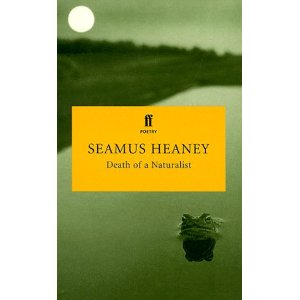Review: ‘Death of a Naturalist’ by Seamus Heaney
 Despite my resolution to read more poetry this year I don’t seem to have achieved that aim terribly well. Probably because I can’t read poetry on the train as I find poems tend to be too short for me not to become distracted by what’s going on around me. I also find that poetry requires a different type of concentration to a novel; a good novel absorbs me so that I forget where I am, but a good poem expects me to use my brain and engage with it in a different way. This is far more difficult to manage when surrounded by commuters at stupid o’clock in the morning. March’s TBR Lucky Dip provided a timely reminder that I should probably get back to the poetry books when it selected Seamus Heaney’s Death of a Naturalist for me to read a few months ago. I finished it at the beginning of April and now it’s finally getting its review, so my thoughts may be a little scattered to say the least.
Despite my resolution to read more poetry this year I don’t seem to have achieved that aim terribly well. Probably because I can’t read poetry on the train as I find poems tend to be too short for me not to become distracted by what’s going on around me. I also find that poetry requires a different type of concentration to a novel; a good novel absorbs me so that I forget where I am, but a good poem expects me to use my brain and engage with it in a different way. This is far more difficult to manage when surrounded by commuters at stupid o’clock in the morning. March’s TBR Lucky Dip provided a timely reminder that I should probably get back to the poetry books when it selected Seamus Heaney’s Death of a Naturalist for me to read a few months ago. I finished it at the beginning of April and now it’s finally getting its review, so my thoughts may be a little scattered to say the least.
Death of a Naturalist is a wonderful collection of poems which chiefly deal with Heaney’s rural Irish childhood and heritage. Individually, they are earthy and emotional and they combine together to form an impressive and coherent whole picture. What sets Heaney’s poetry apart is the sensuous quality of the language, how the words sound when said aloud and how they feel in the mouth. He seems to take great delight in rhyme, in onomatopoeia, in sibilant and plosive sounds and the physicality of words. This is definitely a collection which begs to be read aloud.
The poems themselves are a potent blend of nostalgia towards innocent childhood activities and a peculiar menace or sorrow. This becomes more pronounced as the book advances, ranging from the wild, childish imaginings of the titular poem ‘Death of a Naturalist’, in which Heaney pictures the frogs and frogspawn that so absorb his younger self fighting back:
The great slime kings
Were gathered there for vengeance and I knew
That if I dipped my hand the spawn would clutch it.
This becomes more explicit in poems such as ‘The Early Purges’, where he observes animals being killed:
Still, living displaces false sentiments
And now, when shrill pups are prodded to drown
I just shrug, ‘Bloody pups’. It makes sense:‘Prevention of cruelty’ talk cuts ice in town
Where they consider death unnatural
But on well-run farms pests have to be kept down.
And continues with the most heartbreaking line which finishes ‘Mid-term Break’, about the death of Heaney’s younger brother while he was away at school:
A four foot box, a foot for every year.
That’s not to say that Death of a Naturalist is all doom and gloom, but it is deeply felt and evocatively written all the way through.
Death of a Naturalist by Seamus Heaney. Published by Faber, 199, pp. 46. Originally published in 1966.